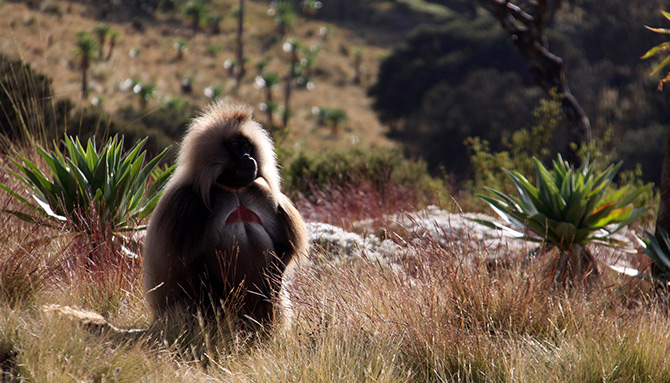The Park was one of the first four sites to be inscribed on the World Heritage List in 1978. Massive erosion of the Ethiopian plateau has created one of the most spectacular landscapes in the world: jagged mountain peaks, deep valleys and precipices sheer for 1,500 metres. The Park is the refuge of the extremely rare Ethiopian wolf, gelada baboon and Walia ibex,a goat unique to Ethiopia. After the site’s management was transferred from Addis Abeba to the Amhara region in 1997, a committee for the Park’s rehabilitation was set up, the budget and staff increased, there was local participation in decisions, resettlement of farmers, excision of villages and extension of the Park.
Threats to the Site: The World Heritage Committee placed the Park on the List of World Heritage in Danger in 1996 because of decline in the population of the Walia ibex due to human settlement, grazing, agriculture and road construction. The ibex may now number over 500 and be on the increase but the Ethiopian wolf remains extremely rare.
The Simen Mountains are a part of the Afro-alpine Centre of Plant Diversity, with high unquantified levels of endemism due to past isolation (5-10 species), though as a result of their recent post-volcanic post-glacial history they are low in diversity compared with other Afro-alpine regions (Magin, 2001). The Park, on the margins of the Palaearctic biome, preserves a representative part of the Ethiopian Tropical Seasonal Highland biome and contains vegetation characteristic of each. The floristically rich vegetation grows in four belts related to altitude: Afromontane forest, Hypericum woodland, Afromontane grassland and Afro-alpine moorland. Species in the latter two biomes show xeromorphic adaptations to extreme high altitude conditions, and much speciation. However the heavy overgrazing has eroded and degraded the grassland which is now very unproductive. In 1996, of 900 ha of Afro-alpine vegetation, 25% was heavily overgrazed, 60% heavily grazed and 15% more or less natural (Debonnet et al, 2006).




